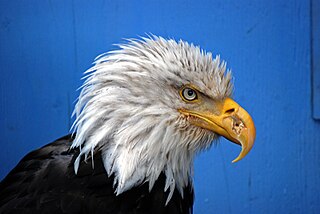
The bald eagle is a bird of prey found in North America. A sea eagle, it has two known subspecies and forms a species pair with the white-tailed eagle, which occupies the same niche as the bald eagle in the Palearctic. Its range includes most of Canada and Alaska, all of the contiguous United States, and northern Mexico. It is found near large bodies of open water with an abundant food supply and old-growth trees for nesting.

The golden eagle is a bird of prey living in the Northern Hemisphere. It is the most widely distributed species of eagle. Like all eagles, it belongs to the family Accipitridae. They are one of the best-known birds of prey in the Northern Hemisphere. These birds are dark brown, with lighter golden-brown plumage on their napes. Immature eagles of this species typically have white on the tail and often have white markings on the wings. Golden eagles use their agility and speed combined with powerful feet and large, sharp talons to hunt a variety of prey, mainly hares, rabbits, and marmots and other ground squirrels. Golden eagles maintain home ranges or territories that may be as large as 200 km2 (77 sq mi). They build large nests in cliffs and other high places to which they may return for several breeding years. Most breeding activities take place in the spring; they are monogamous and may remain together for several years or possibly for life. Females lay up to four eggs, and then incubate them for six weeks. Typically, one or two young survive to fledge in about three months. These juvenile golden eagles usually attain full independence in the fall, after which they wander widely until establishing a territory for themselves in four to five years.

The great grey owl is a very large owl, documented as the world's largest species of owl by length. It is distributed across the Northern Hemisphere, and it is the only species in the genus Strix found in both Eastern and Western Hemispheres. In some areas it is also called Phantom of the North, cinereous owl, spectral owl, Lapland owl, spruce owl, bearded owl, and sooty owl.

War Eagle is a battle cry, yell, or motto of Auburn University and supporters of Auburn University sports teams, especially the Auburn Tigers football team. War Eagle is a greeting or salutation among the Auburn Family. It is also the title of the university's fight song and the name of the university's golden eagle.

The Alaska Raptor Center is a raptor rehabilitation center in Sitka in the U.S. state of Alaska. Located on a 17–acre campus bordering the Tongass National Forest and the Indian River. The mission of the Alaska Raptor Center is to promote and enhance wild populations of raptors and other avian species through rehabilitation, education and research. Although the main patients are raptors, especially bald eagles, the center will take any bird in need of care. The Alaska Raptor Center receives between 100–200 birds a year, with many suffering from some sort of trauma. They have treated birds with injuries from electrocution, collisions, gunshot wounds, leg hold traps, starvation, disease and lead poisoning.

The Goldbelt Tram (formerly Mount Roberts Tramway) is an aerial tramway located directly south of downtown Juneau in the U.S. state of Alaska. In operation since 1996, the tram makes a six-minute ascent of 3,819-foot (1,164 m) up Mount Roberts from the cruise ship docks (just feet above sea level) to a height of about 1,800 feet (550 m). A restaurant, theater, retail shop, and nature center are located at the top of the tramway, as well as connections to trails leading both up and down the mountain. A trail up the mountain leads to a large cross erected by Roman Catholic Father Brown in the early 1900s.

Mount Juneau is a 3,576-foot (1,090 m) massif in Southeast Alaska just one and a half miles east of downtown Juneau, Alaska, in the Boundary Ranges.

The Cascades Raptor Center is a nature center and wildlife hospital in Eugene, Oregon that specializes in raptor rehabilitation. As of November 2020, permanent inhabitants of the center include 37 individual birds from 21 species.

Nora Marks Keixwnéi Dauenhauer was a Tlingit poet, short-story writer, and Tlingit language scholar from Alaska. She won an American Book Award for Russians in Tlingit America: The Battles of Sitka, 1802 And 1804. Nora was Alaska State Writer Laureate from 2012 - 2014.

Ernestine Saankaláxt Hayes belongs to the Kaagwaaataan clan, also known as the wolf house, representing the Eagle side of the Tlingit Nation. Hayes is a Tlingit author and an Emerita retired professor at the University of Alaska Southeast (UAS) in Juneau, Alaska. As an author, Hayes is a (Tlingit) memoirist, essayist, and poet. She was selected as the Alaska State Writer Laureate in 2016 and served in that position until 2018.

The Rocky Mountain Raptor Program is a 501(c)(3) non-profit wildlife conservation organization based in Fort Collins, Colorado that rescues, rehabilitates and releases injured birds of prey—including eagles, hawks, falcons and owls—and, through its comprehensive Environmental Education program, teaches the importance of preserving wildlife and wild places for future generations. RMRP has developed a national reputation for the treatment of raptor illness and injuries, cage design, volunteer management, community involvement, and youth development. Raptor patients receive fracture repair, wound care, fluids to combat dehydration, nutritious food, and regular medical attention to promote healing. Raptors that are permanently injured and therefore non-releasable may become an Educational Ambassador. These raptors are the cornerstone of our Environmental Education program, which makes more than 200 presentations each year throughout the region, teaching children and adults about the importance of protecting wildlife and wild places. The program's environmental education program, particularly in the K-12 sector, has developed an excellent reputation throughout Colorado. RMRP reaches more than 15,000 schoolchildren annually. Numerous outreach exhibits throughout the state reach hundreds of thousands of people annually. Rocky Mountain Raptor Program currently averages about one admission and several injured raptor calls each day, and 77% of treatable raptors are released.

Bird trapping techniques to capture wild birds include a wide range of techniques that have their origins in the hunting of birds for food. While hunting for food does not require birds to be caught alive, some trapping techniques capture birds without harming them and are of use in ornithology research. Wild birds may also be trapped for their display in captivity in zoological gardens or for keeping as a pet. Bird trapping was formerly unregulated, but to protect bird populations most countries have specific laws and regulations.

Trichomonas gallinae is a cosmopolitan parasite of birds including finches, pigeons, doves, turkeys, chickens, parrots, raptors. The condition in birds of prey is called frounce. It is believed to be an ancient pathogen causing frounce-like symptoms in theropod dinosaurs. The same condition in pigeons is commonly called canker.

The Juneau Raptor Center (JRC) was a raptor rehabilitation center in Juneau in the U.S. state of Alaska. Founded in 1987 and located in the Tongass National Forest, its mission was the rehabilitation of sick and injured eagles, hawks, falcons, owls, ravens, hummingbirds and other avian wildlife brought in from Juneau and Southeast Alaska. The JRC was licensed by the US Fish and Wildlife Service to handle eagles and migratory birds, and was governed in part by the Bald and Golden Eagle Protection Act and the Migratory Bird Treaty Act of 1918.

Juneau Mountain Rescue (JMR) is a mountain search and rescue agency, located in Juneau, Alaska, United States. JMR is a member of the Alaska Search and Rescue Association, and facilitates rescues involving wilderness terrain, rope rescues on rock faces, ice and snow fields, glaciers, and during avalanches, medical evacuations, missing persons cases, aircraft crashes and other disasters. An all-volunteer organization, JMR coordinates with Capital City Fire/Rescue, the Juneau Police Department, the Alaska State Troopers, the United States Coast Guard, and other emergency response agencies during search and rescue operations.

Capital City Fire/Rescue (CCFR) provides fire suppression and emergency medical services to the city of Juneau, Alaska, United States.

Ermalee Hickel was an American public figure and philanthropist who served as the second and seventh First Lady of Alaska from 1966 to 1969 and again from 1990 to 1994. She was the wife of the former Governor of Alaska Wally Hickel and one of the last members of Alaska's generation of pioneer political families.
Mary Lou King is an American environmental activist, educator, and writer.
The Wild Bird Fund is a non-profit animal hospital on the Upper West Side of Manhattan in New York City. It is the city's first and only wild animal hospital.


















